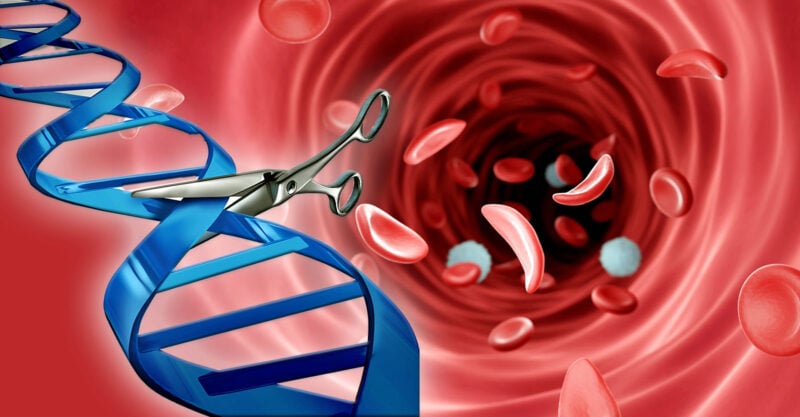Gene-Edited Humans? Scientists Sound Alarm as UK Approves CRISPR Therapy to Treat Blood Disease
U.K. regulators this week approved the first CRISPR therapy to treat humans and U.S. regulators could approve the therapy — designed to treat blood disorders — as early as December. Meanwhile, the U.S. company behind another CRISPR technology, “base editing,” reported a successful initial study — despite 2 of 10 subjects experiencing heart attacks, resulting in one trial participant’s death.
U.K. regulators on Thursday approved a therapy that uses CRISPR gene editing technology to treat two blood disorders. U.S. federal regulators are poised to approve that same treatment in December.
The exa-cel therapy, which goes by the brand name Casgevy, is the world’s first CRISPR therapy for humans to be approved for the market.
CRISPR is a gene editing technology that acts as a pair of “genetic scissors,” allowing scientists to edit sections of DNA by “snipping” specific portions of it and replacing them with new segments. First announced in a 2012 paper, CRISPR is celebrated as a cheap and easy way to edit genes.
Its inventors won the Nobel Prize in chemistry in 2020. In recent years, applications in plant manipulation and research on possible use in humans have proliferated as the technology has been promoted as a potential solution to problems running from disease, to food security to climate change.
But that research has been highly controversial, and a long series of papers has been published detailing the unintended effects of CRISPR gene editing, which has been found to produce many types of serious unintended DNA damage.
Casgevy is designed to treat two blood conditions: sickle cell disease and beta thalassemia. Sickle cell disease, also known as sickle cell anemia, most commonly occurs in people of African or Caribbean descent. It can cause debilitating pain.
People with beta thalassemia, which can cause mild or severe anemia, can require regular blood transfusions.
Both genetic conditions are caused by errors in the genes for hemoglobin, a protein that lets red blood cells transport oxygen around the body — and both conditions can be fatal.
The therapy, developed by Vertex Pharmaceuticals and CRISPR Therapeutics, was approved after a sickle cell trial that followed only 29 out of a total of 45 participants for 16 months. Twenty-eight of those followed had no pain after one year, Nature reported.
In the clinical trial for beta thalassemia, 39 of the 42 trial participants did not need to have a red blood cell transfusion for at least 12 months after receiving Casgevy. They typically need blood transfusions every three to five weeks.
How does the treatment work?
For both diseases, the treatment is administered by taking blood-producing stem cells out of the patient’s bone marrow and editing the genes using CRISPR, also known as CRISPR/Cas9, named for the protein used to cut the DNA.
The technology targets a gene called BCL11A that typically disrupts the production of a kind of hemoglobin typically made only by fetuses.
The Cas9 locates the gene and cuts the DNA strands to make the gene stop working. In the process, it unleashes the production of fetal hemoglobin, which doesn’t have the same abnormalities as adult hemoglobin in people with those blood disorders.
Prior to treatment, patients undergo an intense and risky treatment called “myeloablative conditioning,” which prepares their body to receive the gene-edited cells. The gene-edited cells are then infused back into the body after they are edited. Patients may need to spend months in the hospital before and after the treatment.
The treatment will likely be very expensive — roughly $2 million — as we enter the so-called “era of one-shot, multimillion-dollar genetic cures,” although the companies have not named the price.
‘It only takes one cell within large pool of edited cells to … cause cancer’
Although most media coverage celebrated new CRISPR-based treatments, scientific research has raised concerns about the use of the technology, which can cause serious genetic damage.
This can occur, for example, when the cell starts to repair itself after the initial CRISPR-targeted cut, regardless of how “precise” that cut may be.
Studies have found that CRISPR edits intended to knock out the function of a gene have failed to do so. Instead, they have damaged the genes, causing unknown mutations.
In other cases, CRISPR made unexpectedly large deletions, causing greater genetic damage than previously thought.
Michael Antoniou, Ph.D., head of the Gene Expression & Therapy Group at King’s College London, told The Defender:
“It is well established that CRISPR/Cas9 gene editing is not only prone to off-target genetic damage but also a wide range of unintended mutations even at the intended edit site. This can negatively impact the function of multiple genes, which can lead to cancer.
“It is thus vital that those responsible for administering the gene editing therapy conduct unbiased genome-wide analysis of treated patients for potentially life-damaging DNA mutations. This is essential as it only takes one cell within the large pool of edited cells to go wrong and cause cancer.”
The clinical trials didn’t find cancer in any of the subjects, but the test group was small and patients were followed for only 16 months. Vertex said it plans to follow clinical trial subjects for 15 years but told regulators they “saw no reason to hold the treatment back,” The New York Times reported.
U.S. Food and Drug Administration (FDA) advisory committee member Alexis Komor noted that there can always be additional safety studies, and it didn’t make sense to be “expecting perfection at the expense of progress.”
CRISPR for high cholesterol? CEO of biotech company developing treatment hopes someday everyone will take it
A second CRISPR medical treatment made headlines this week when researchers reported that 2 of 10 participants had heart attacks — and one of those died — in the first human trial using a CRISPR-derived technique known as “base editing” to reduce cholesterol.
Yet the study, presented at an American Heart Association meeting last Sunday, is being hailed as “a potential landmark proof-of-concept” by NPR and as showing “promising results” by Nature and as a “breakthrough” by Science because it reduced the amount of low-density lipoprotein (LDL), or “bad cholesterol” in the surviving trial participants’ blood by up to 55%.
The FDA granted approval to Verve Therapeutics, the biotech company behind the treatment, to enroll U.S. patients to participate in the next phase of the study with no changes to the drug protocol.
Investors were more cautious. The company’s share price fell 37% in premarket trading following the presentation of its trial results.
The treatment rewrites genetic code inside the body by using a blood transfusion to deliver a base-editor designed to disable a liver protein that regulates LDL.
Verve reported the interim results of a phase 1b trial for the treatment, conducted in the U.K. and New Zealand, on its website and at the American Heart Association meeting and announced it will continue the trial next year in the U.S.
“This technology is being promoted as “super precise,” but this is not accurate, according to John Fagan, Ph.D., chief scientist and CEO of the nonprofit independent lab Health Research Institute.
Fagan told The Defender:
“‘Gene-editing’ is ‘directed’ in the sense that it can be programmed to make specific intended changes in the DNA, but, along with the intended gene-edits, unintended ‘off-target’ effects often occur, which can be damaging to health and even to survival.”
Verve conducted its trial on people with heterozygous familial hypercholesterolemia (HeFH), a genetic disease that causes high LDL levels from birth. But Verve hopes the treatment will be used as a one-time alternative to the daily use of statins by the tens of millions of people diagnosed with high cholesterol.
Verve CEO Sekar Kathiresan told Science he hoped it might one day be given to older adults more generally to ward off disease. “Down the road, maybe you turn 50, and this is what you get and it prolongs your life,” Kathiresan said. “That’s the ultimate vision.”
But Fagan said that given the serious health risks associated with this technology, there was no justification for such a proposal.
“Such methods should be used only as a last resort,” he said.
CRISPR-based technologies being fast-tracked ‘with dangerous hubris’
Verve’s trial is the first to use a base-editing treatment inside humans.
CRISPR typically works by severing both strands of DNA and allowing cells to repair the break. Base editors, developed in 2016 by David Liu’s lab at Harvard University and the Broad Institute, uses the CRISPR technology to alter single bases in the genetic code without breaking both DNA strands — a process the developers say is more precise.
Although a few CRISPR gene therapies have been tested directly in the human body, base editing has not. The first base-editing test on humans earlier this year removed cells from the body of a girl with leukemia, edited them in a lab and then put them back into her body.
This therapy injects people directly with the treatment, which is designed to permanently turn off a gene in the liver called PCSK9, which controls the LDL cholesterol. This can raise the risk of heart attack and stroke.
Verve enrolled 10 people in the trial with HeFH, which affects approximately three million people in the U.S. and Europe. The participants had coronary disease and took statins.
Science explained how the treatment works:
“Its treatment consists of messenger RNA (mRNA) that instructs cells to manufacture the gene editor’s protein components. Packaged in tiny balls of fat called lipid nanoparticles (LNPs) —also used in the mRNA COVID-19 vaccines—it travels to the liver, where an additional RNA strand also carried in the particles guides the base editor to the gene for PCSK9.
“The combo makes a one–base pair change so that cells can produce only shortened, nonfunctional versions of the enzyme.”
But J. Jay Couey, Ph.D., staff scientist for Children’s Health Defense, told The Defender that such LNP-based transfection methodologies have a “crucial weakness” that makes them dangerous and which many experts, including Dr. Sucharit Bhakdi, Michael Yeadon, Ph.D., and Byram Bridle, Ph.D., have been highlighting for years.
Couey said:
“One striking commonality among many of these examples of CRISPR tech being fast-tracked is the assumption that LNPs can be used to ‘target’ these mRNAs to particular cells.
“We have statements from the inventor of the LNP technology, Pieter Cullis, freely admitting they cannot target LNPs to a particular tissue.
“Therefore, like the LNP-based transfections that were called investigational vaccines for SARS-CoV2, these therapies will spread throughout the body to random tissues with a bouquet of potential unknown short- and long-term consequences associated with transfecting random cells throughout the body.”
Six of the 10 patients in the study received sub-clinical doses and no reduction in LDL levels was reported. Of the three who received a high dose, two patients had 39% and 48% reductions in their LDL levels, and the patient who had the highest dose had a 55% LDL reduction that lasted for six months.
Participants experienced flu-like symptoms along with a temporary increase in liver enzymes. One patient in the sub-clinical dose group died of a heart attack five weeks after treatment and one who had a clinical dose had a heart attack the day following treatment but survived.
Of the two people who experienced cardiac events, Verve reported that a researcher and an “independent review board” concluded the death was not related to the treatment and the second heart attack, which occurred the day after the treatment, was “potentially related” to treatment.
Verve plans to test the treatment in about 40 patients, but it said it will be enrolling “less severe patients” to try to reduce the enrollment of patients likely to have what it called “unrelated complications” such as heart attack and death.
“What we’re trying to do is develop an entirely new way to treat heart disease,” Kathiresan told NPR in an interview. “We’re super excited. This is the first-ever evidence that one can actually rewrite a single DNA letter in the human liver and have a clinical effect. So we’re thrilled.”
Couey sees things differently. “Drugs like these are getting fast-tracked based on the new and very dangerous assumption that using LNPs carrying mRNA to transfect healthy humans has been proven safe by their use as a pandemic countermeasure.”
But that’s not the case, Couey said.
“The so-called success of the Nobel Prize-worthy technology in the COVID-19 shots — which we now know to have caused an ever-expanding list of problems while not providing meaningful health benefits — is taken as proof that any combination of LNP and mRNA is basically safe, despite evidence to the contrary.”
He added: “The fake momentum is being used to fast track gene therapy in general with dangerous hubris.”
This article was originally published by The Defender
Suggest a correction





